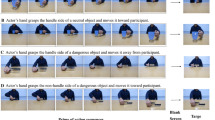Abstract
Previous studies have shown that object observation can automatically evoke motor programs for specific actions; this is referred to as affordance. Recent studies have evidenced that individuals are sensitive to the difference between dangerous and neutral objects. This study explored the influence of irrelevant dangerous object on individuals’ responses to the target object. In a priming task, participants were required to respond to a target object, which was preceded by a prime object. The object types varied between dangerous and neutral objects. The results revealed that the affordance of the neutral object only occurred when the orientation of the prime object corresponded to that of the target object. The affordance of dangerous object was modulated by a dangerous prime object. When the orientation of the prime object did not correspond to that of the target object, the affordance of the dangerous object was observed; whereas, when the orientation was in correspondence, the congruency effect was reversed. These findings suggest that object-action priming is modulated by the danger level of objects.


Similar content being viewed by others
References
Ambrosecchia, M., Marino, B. F. M., Gawryszewski, L. G., & Riggio, L. (2015). Spatial stimulus-response compatibility and affordance effects are not ruled by the same mechanisms. Frontiers in Human Neuroscience, 9, 283.
Anelli, F., Borghi, A. M., & Nicoletti, R. (2012). Grasping the pain: Motor resonance with dangerous affordances. Consciousness and Cognition, 21, 1627–1639.
Anelli, F., Nicoletti, R., Bolzani, R., & Borghi, A. M. (2013). Keep away from danger: Dangerous objects in dynamic and static situations. Frontiers in Human Neuroscience, 7, 344.
Caligiore, D., Borghi, A. M., Parisi, D., & Baldassarre, G. (2010). TRoPICALS: A computational embodied neuroscience model of compatibility effects. Psychological Review, 117, 1188–1228.
Chao, L. L., & Martin, A. (2000). Representation of manipulable man-made objects in the dorsal stream. NeuroImage, 12, 478–484.
Coello, Y., Bourgeois, J., & Iachini, T. (2012). Embodied perception of reachable space: How do we manage threatening objects? Cognitive Processing, 13, 131–135.
Ellis, R., & Tucker, M. (2000). Micro-affordance: The potentiation of components of action by seen objects. British Journal of Psychology, 91, 451–471.
Gallivan, J. P., Cavina-Pratesi, C., & Culham, J. C. (2009). Is that within reach? fMRI reveals that the human superior parieto-occipital cortex encodes objects reachable by the hand. The Journal of Neuroscience, 29, 4381–4391.
Gentilucci, M. (2003). Object motor representation and language. Experimental Brain Research, 153, 260–265.
Gibson, J. J. (1979). The ecological approach to perception. Boston: Houghton Mifflin.
Grèzes, J., & Decety, J. (2002). Does visual perception of object afford action? Evidence from a neuroimaging study. Neuropsychologia, 40, 212–220.
Grèzes, J., Tucker, M., Armony, J., Ellis, R., & Passingham, R. E. (2003). Objects automatically potentiate action: An fMRI study of implicit processing. European Journal of Neuroscience, 17, 2735–2740.
Jax, S. A., & Buxbaum, L. J. (2010). Response interference between functional and structural actions linked to the same familiar object. Cognition, 115, 350–355.
Jax, S. A., & Buxbaum, L. J. (2013). Response interference between functional and structural object-related actions is increased in patients with ideomotor apraxia. Journal of Neuropsychology, 7, 12–18.
Kalénine, S., Wamain, Y., Decroix, J., & Coello, Y. (2016). Conflict between object structural and functional affordances in peripersonal space. Cognition, 155, 1–7.
Proverbio, A. M. (2012). Tool perception suppresses 10-12Hz μ rhythm of EEG over the somatosensory area. Biological Psychology, 91, 1–7.
Rizzolatti, G., & Matelli, M. (2003). Two different streams form the dorsal visual system: Anatomy and functions. Experimental Brain Research, 153, 146–157.
Symes, E., Ellis, R., & Tucker, M. (2007). Visual object affordances: Object orientation. Acta Psychologica, 124, 238–255.
Tucker, M., & Ellis, R. (1998). On the relations between seen objects and components of potential actions. Journal of Experimental Psychology: Human Perception and Performance, 24, 830–846.
Tucker, M., & Ellis, R. (2001). Micro-affordance of grasp type in a visual categorisation task. Visual Cognition, 8, 769–800.
Vingerhoets, G., Vandamme, K., & Vercammen, A. (2009). Conceptual and physical object qualities contribute differently to motor affordances. Brain and Cognition, 69, 481–489.
Wamain, Y., Gabrielli, F., & Coello, Y. (2016). EEG μ rhythm in virtual reality reveals that motor coding of visual objects in peripersonal space is task dependent. Cortex, 74, 20–30.
Wamain, Y., Sahaï, A., Decroix, J., Coello, Y., & Kalénine, S. (2018). Conflict between gesture representations extinguishes μ rhythm desynchronization during manipulable object perception: An EEG study. Biological Psychology, 132, 202–211.
Wilf, M., Holmes, N. P., Schwartz, I., & Makin, T. R. (2013). Dissociating between object affordances and spatial compatibility effects using early response components. Frontiers in Psychology, 4, 591.
Zhao, L. (2017). Separate pathways for the processing of affordance of neutral and dangerous object. Current Psychology, 36, 833–839.
Acknowledgments
This study was supported by a grant from Humanity and Social Science Youth foundation of Ministry of Education of China (17XJC190011), Shaanxi philosophy and social science fund (2017P016), and Programs of Scientific Research Foundation for Doctor (ZK2018032) of Baoji University of Arts and Sciences.
Author information
Authors and Affiliations
Corresponding author
Ethics declarations
Conflict of Interest
There are no conflicts of interest to declare.
Ethical Approval
All procedures performed in studies involving human participants were in accordance with the ethical standards of the institutional research committee and with the 1964 Helsinki declaration and its later amendments or comparable ethical standards.
Informed Consent
Informed consent was obtained from all individual participants included in the study.
Rights and permissions
About this article
Cite this article
Zhao, L. The influence of irrelevant dangerous objects on the action activation of target objects. Curr Psychol 39, 2320–2325 (2020). https://doi.org/10.1007/s12144-018-9939-y
Published:
Issue Date:
DOI: https://doi.org/10.1007/s12144-018-9939-y




